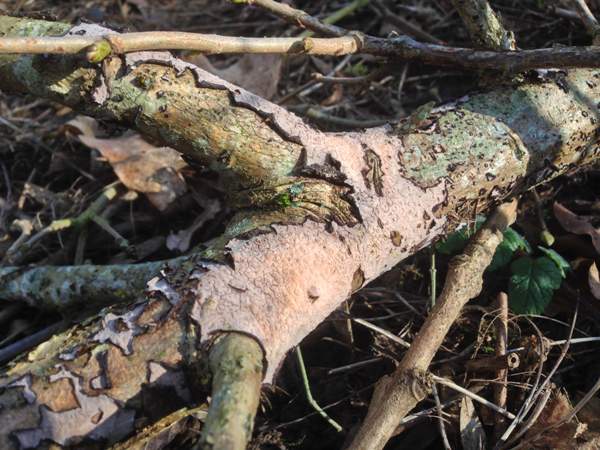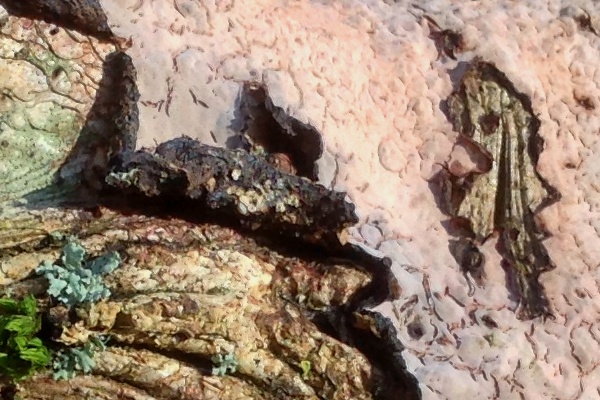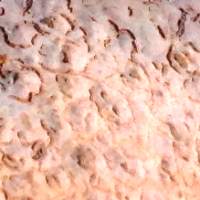Peniophora quercina (Pers.) Cooke - Oak Crust
Phylum: Basidiomycota - Class: Agaricomycetes - Order: Russulales - Family: Peniophoraceae
Distribution - Taxonomic History - Etymology - Identification - Culinary Notes - Reference Sources

A lovely pinkish corticioid (crust) fungus, Peniophora quercina is a very common in Britain and Ireland.
Distribution
Peniophora quercina is abundant and widespread throughout Britain and Ireland. On mainland Europe this wood-rotting crust fungus is found from Scandinavia right down to the Mediterranean region, wherever oak trees occur. This species also occurs in America.

Taxonomic history
This crust fungus was described in 1801 by Christiaan Hendrik Persoon, who gave it the scientific name Thelephora quercina.
In 1879 English mycologist Mordecai Cubitt Cooke transferred this species to the genus Peniophora, and its scientific name, still generally accepted today, became Peniophora quercina.
Synonyms of Peniophora quercina include Thelephora quercina Pers., Auricularia corticalis Bull., and Stereum tuberculosum Velen.
Etymology
Peniophora, the generic name, means tough, and crust fungi in this genus certainly can be difficult to tear when you want to take a small sample for investigation. The specific epithet quercina refers to the fact oak genus of trees on which this crust species mostly occurs
Identification guide
 |
FruitbodyEntirely resupinate when young, sometimes becoming slightly detached at the edges when old; 1 to 3.5 mm thick; fertile surface may be either smooth or somewhat uneven; waxy and pale lilac when damp becoming pink and hard when dry. Edges often curl up and peel back in very dry weather.
|
SporesAllantoid (curved cylindrical, like sausages), smooth, 8-12 x 3-4µm.. Spore printPink. |
|
Odour/taste |
No noticeable odour; tough, tasteless and inedible. |
Habitat & Ecological role |
Saprobic, on dead oak wood and occasionally on living oaks. |
Season |
All through the year, shedding spores in autumn. |
Similar species |
Bleeding Oak Crust Stereum gausapatum is darker; it also grows mainly on dead trunks and branches of oak trees, Quercus species. Stereum subtomentosum has an upper surface that is zoned in various shades of greyish-orange or greyish white; it usually forms reflexed crusts or brackets. Stereum hirsutum is hairy on its upper surface and often forms reflexed crusts or brackets. |
Culinary Notes
Tough and leathery, these tasteless fungi are inedible and of no culinary value.
Reference Sources
Pat O'Reilly (2016). Fascinated by Fungi, First Nature Publishing.
BMS List of English Names for Fungi.
Paul M. Kirk, Paul F. Cannon, David W. Minter and J. A. Stalpers. (2008). Dictionary of the Fungi; CABI.
Taxonomic history and synonym information on these pages is drawn from many sources but in particular from the British Mycological Society's GB Checklist of Fungi.
Fascinated by Fungi. Back by popular demand, Pat O'Reilly's best-selling 450-page hardback book is available now. The latest second edition was republished with a sparkling new cover design in September 2022 by Coch-y-Bonddu Books. Full details and copies are available from the publisher's online bookshop...

